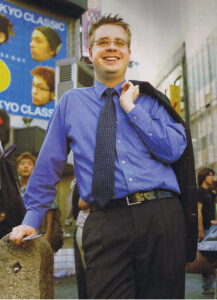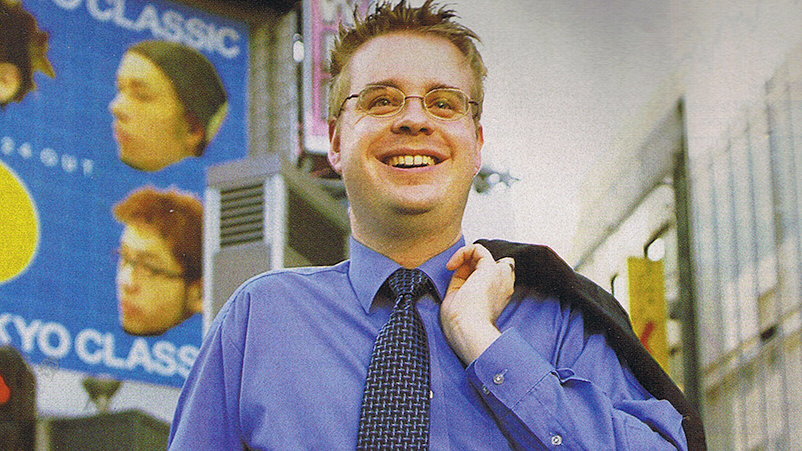“Tokyo Vice” season 2 premiered on Max on February 8, 2024. Those who watched Season One will know the story is loosely based on the book by Jake Aldenstein. The book was set earlier in the 1990s, but the series sees the protagonist, Jake Aldenstein, played by Ansel Elgort, join the leading Japanese newspaper in 1999. He becomes one of the few pioneering foreigners in the Japanese workforce by doing so. As a new reporter on the crime beat, Aldenstein digs into the seedy underworld of Tokyo, the “city with no murders”, while facing challenges in both the workplace and the city as a foreigner in a foreign land.
By coincidence, I also joined the Japanese corporate workforce in 1999 after completing my postgraduate degree at the University of Sheffield. A recruitment process of interviews at a job fair in London and later at headquarters in Tokyo brought me to a position at NTT DoCoMo, Japan’s largest mobile phone carrier, when the company was beginning to lay the groundwork of its international strategy, which included recruiting junior employees from overseas. Joining in September of that year, I was assigned to a select team of employees who had just launched the i-mode mobile internet service. Over the next several years, this service would provide internet access to over 50 million Japanese. It would become the backbone of the company’s early international business ventures.
When I watched Tokyo Vice and the workplace experiences of Jake Aldenstein, I began to reflect deeper on my own experiences in a very Japanese office and how those experiences have contributed to my success in business over the years. I fondly remember my time with DoCoMo and the experience that set the groundwork for my future success, but there was still a combination of rough treatment, cultural clashes, and learning to bridge the cultural gap that are all common themes for many of us who began our professional work life in Japanese companies.
Pioneering Foreigners in Japanese Workforce – 1999 Situation
In 2023, the number of foreigners in the workplace in Japan exceeded two million. (Nikkei, 2024), almost a 16-fold increase from the 125,726 foreign residents with a working residency status in 1999. Of those residents, more visas were issued to entertainers than humanities specialists. Fewer still were issued to engineers and other technical experts. Approximately 300,000 students performing part-time jobs or technical interns were in the workforce, with just over half a million foreigners working in Japan. (METI, 2003) Despite nearly a decade of high unemployment after the end of the bubble economy, the Cabinet in August of 1999 approved a new position on foreigners working in Japan, declaring that “under the circumstances, the government will more actively promote the acceptance of foreign workers in professional or technical fields from the standpoint of invigorating and internationalizing the country’s economy and society.” (Ogawa, 2004)
Against this backdrop, in September 1999, I stepped into a Japanese office unprepared for the culture shock I was about to experience. I spent three years as an English teacher in the JET Program in a small fishing village in the northern Aomori prefecture on the Sea of Japan. I had been the only foreigner for miles and treated like a celebrity. I was recruited while completing a postgraduate degree in East Asian Business from the University of Sheffield in the UK. Neither of these experiences had prepared me nor my colleagues for the next year of learning the ropes in a Japanese company.
Culture Shock
I was excited. When I walked into the Kamiyacho office, I was nervous, but I had the confidence of a Canadian and believed I would make a difference. My group director had been educated in the US, and several of my colleagues were kind and helpful as my “sempai.” However, most employees were neither aware of nor aligned with the company’s new strategy to become more global. I was one of a few new foreign employees in the company and the only one on my team. Other foreigners joined me in the same division, and there was a scattering of other foreign employees in different groups, including corporate sales and the international business department. We each experienced challenges in our ways based on the environments in which we were placed.
I enjoyed being in one of the more cutting-edge teams in the company, but I also followed the training and development of the average Japanese employee. This meant attending internal training courses. I arrived late in the summer and missed the annual first-year training in April. Most first-year business recruits spend their time in branch offices where they manage customers or look after shops in the area. As I had been assigned to headquarters and a business department, I spent several weeks doing my branch office training with a group of engineer recruits in Yokohama. At the time, I thought I was wasting my time learning the basics that I may not need to apply again – I had a chip on my shoulder. But in retrospect, those simple basic lessons helped me to better understand the Japanese workplace and how to deal with Japanese customers and partners.

Back at the office, many team members were surprised by how easily I would spar with my managers. While I may not have always been correct, I was outspoken with my ideas. My American-educated director welcomed this, but it surprised many of my Japanese colleagues. The usual complaints of long, hours-long meetings, endless overtime, and unclear communication would challenge me in my first year. I was most surprised by some of my colleagues’ apparent hostility towards me in the team. It was not rare for me to be told to my face that they had “joined a Japanese company” and didn’t understand why I was there.
As the months turned into an entire year, the frustrations of the office began to weigh heavily upon me. More than once, I considered whether I had made the right career decision and whether or not I should already look for a change. I persevered, and after a year on the job, whether it be from more experience with me or the natural progression of year one and year two in a Japanese corporate environment, things became more manageable.
Self-Awareness and Cultural Understanding
My first year was spent in the “content development team”. We were responsible for working with content providers for the service to help them develop their concepts and get them launched on the platform. After some time in that role and learning the ropes from my Japanese sempai, I moved on to our “alliances team.” Through these experiences over two years, I realized my value to the team and how I could work to bridge the gap between the cultures.
As the only foreigner on my team, I was the go-to person when any foreign company came to visit. I worked with Disney, Citibank, Time Warner, and many other international companies to develop their Japanese strategy. At the same time, I helped my Japanese colleagues, who were the subject matter experts, interact with others outside their comfort zone.
I unconsciously began to leverage my uniqueness and differences to succeed personally and professionally within the team and with our partners. I also started to operate better within the team, adapting to and adopting the local customs more effectively. Soon, I was representing NTT DoCoMo on the global stage to promote the company and our service and help other partner companies launch the same in their markets.

While I developed a greater awareness of the Japanese business culture, I realized that my cultural roots and values provided what the company needed to help move its strategy forward. While the Japanese business setting often calls for harmony and good group dynamics to engage with other cultures and other businesses based in different cultures, a good sense of the dynamics and norms of multiple cultures will better contribute to business success. I had become the leopard who can’t change its spots but can use those spots as camouflage, to blend in and adapt to their environments.
Bridging Gaps and Driving Business Success
In 2002, NTT DoCoMo embarked upon a more aggressive global business strategy based on expanding the footprint of the i-mode service. For me, this meant spending approximately one year stationed in The Hague and Paris to work with our two partner companies in both markets to launch their version of the i-mode service. My understanding of service design in Japan and my ability to communicate across cultures contributed to two relatively successful launches.

By embedding myself into both the Dutch and French cultures, I was able to better learn their cultural nuances and values while also understanding those of the Japanese. While I still proudly retained my Canadian values and norms, I could shift back and forth between French and Japanese or Dutch and Japanese cultures to understand the needs of both groups and help launch a service based on Japan’s success while tailored to the local market.
What made me even prouder was that I could bridge the gap at a personal level between team members who, in 1999, didn’t understand why I was there but, in 2002, found themselves in Europe working alongside me with our new partners. At the same time, while recruits from overseas joined the team, I was able to impart some of my newfound understanding to them to help them adapt to their environment.
Pioneering Foreigners in the Japanese Workforce – Conclusions
This February 22nd marks the 25th anniversary of the launch of the i-mode service. Each year (except for the COVID-19 pandemic) the i-mode group has gathered yearly to remember those early days. Some of my colleagues are still at NTT DoCoMo, while others have pursued new career paths. I’m reminded every 22nd of February of the closeness of a Japanese team once everyone understands their role and how to navigate cultural sensitivities.
Japan 25 years later is very different from the Japan of 1999 when I first joined the corporate workforce; yet in many ways, Japan remains very similar. Recent surveys still point to the frustrations of Japanese managers managing foreign employees and foreign employees frustrated with their Japanese work environment. In 1999, there were only approximately 500,000 foreign workers in the country, including those with working permits, technical interns, and students doing part-time work. Today, there are over two million and growing. A continuing decline in the population and the ongoing need for new talent in areas that may be underserved in Japan points to an increased need to embrace more global talent and for more international talent to embrace Japan. The proposal set out by the Cabinet in 1999 remains valid 25 years later.
When I joined NTT DoCoMo in 1999, I thought I was better than everybody else, and it showed! This was not my intention but the cultural norms that were part of my makeup. Despite being exposed to Japan for three years as a teacher, I often ignored group harmony and focused on individual performance. I was the proverbial nail that sticks out to be hammered down. It did not help that the company and, more importantly, the employees were not prepared for more global talent in the team. Looking back on this experience and my 25-year career, I don’t believe in assimilation. Diversity and the unique value of every employee and culture are critical. Having said that, the ability to understand and situationally adapt is essential. Then, as now, having a deeper self-awareness of one’s culture and norms, building a better understanding of the cultures within which one operates, and then having a better ability to bridge cultures and adapt to achieve business results is critical. After all, a leopard can’t change its spots but uses them effectively to blend in when needed.
For more information about my experiences pioneering foreigners in the Japanese workforce and intercultural business, check out my profile here.





